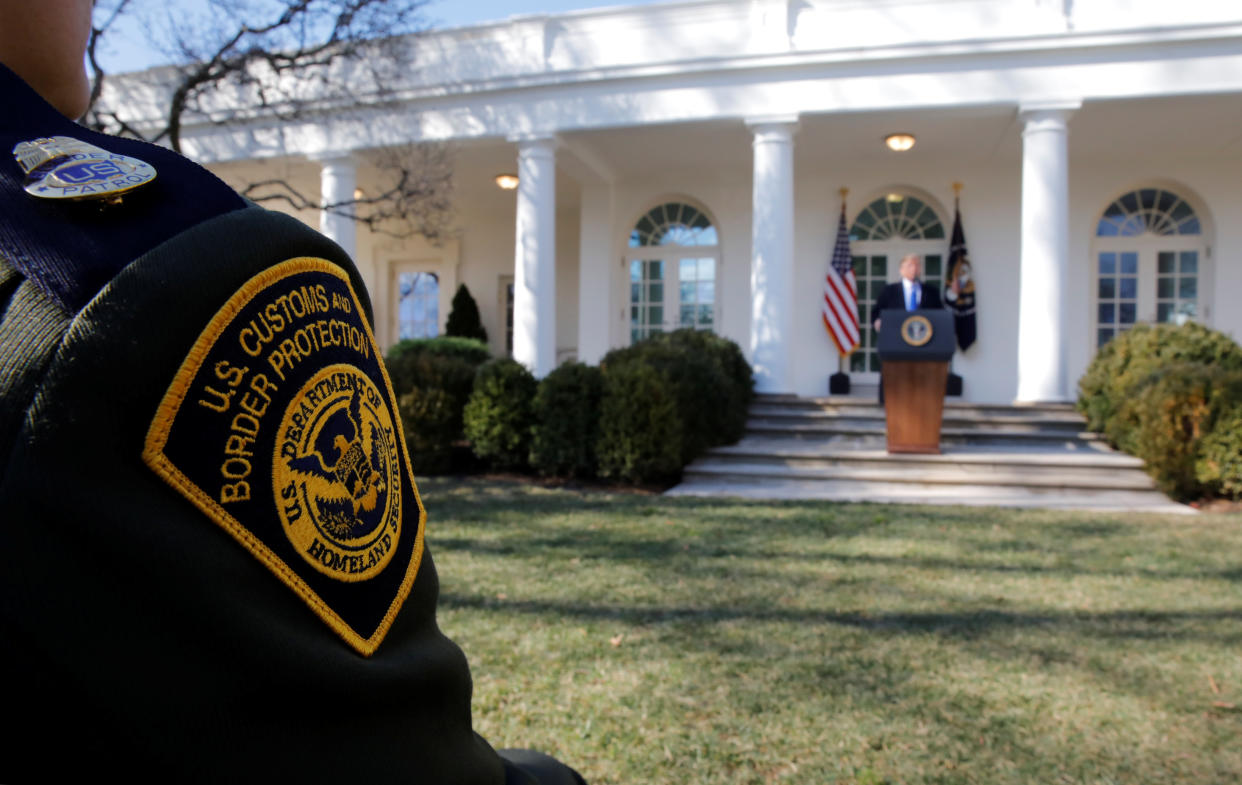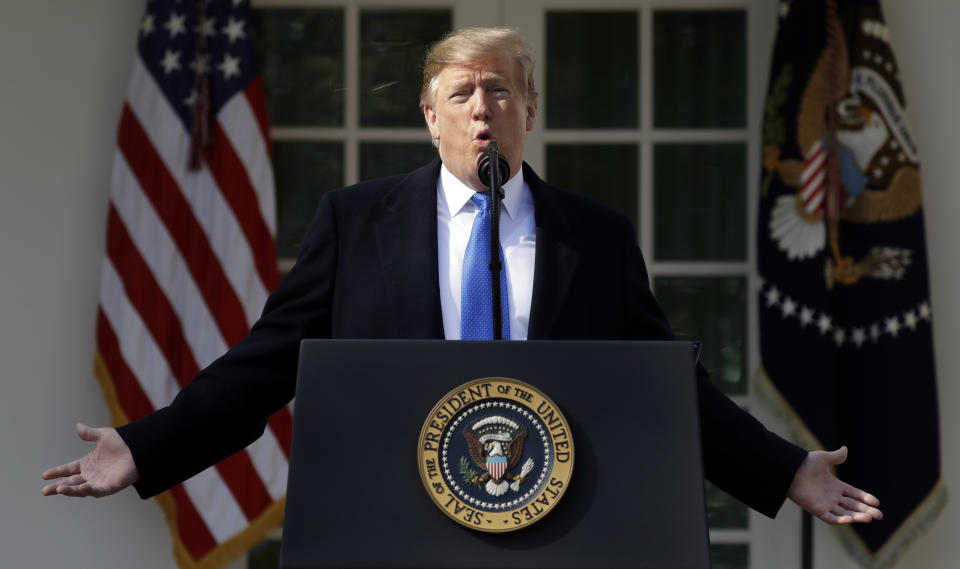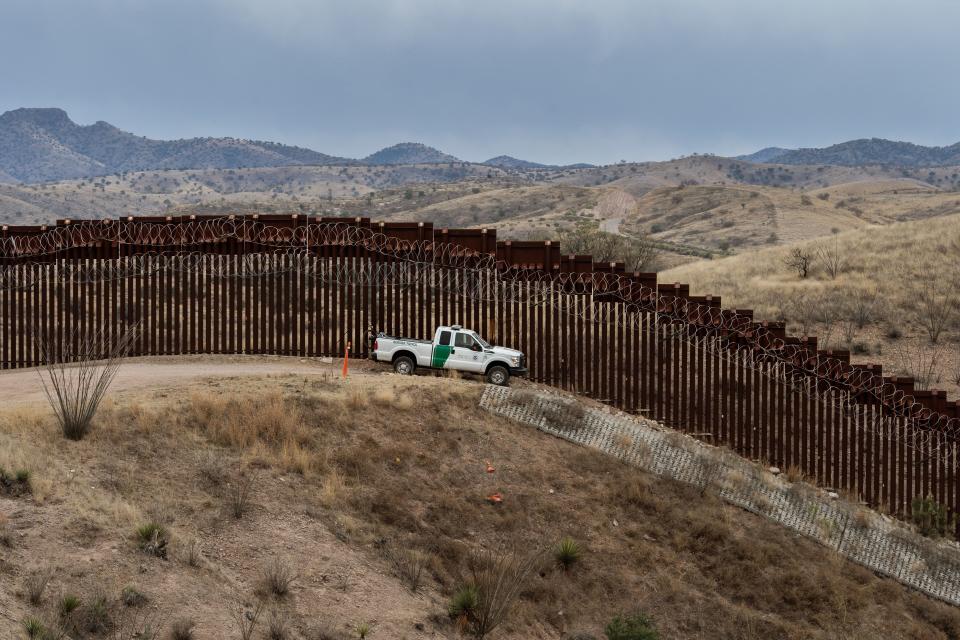Trump doesn’t let facts get in the way of declaring a national emergency

President Trump’s rambling declaration of a national emergency, the intent of which was to fund a barrier along hundreds of miles on the U.S. border with Mexico, was filled with factual inaccuracies, misleading statements and contradictions.
In his Rose Garden remarks on Friday, Trump repeated many of the same disproven claims he has made over the last several weeks about drug smuggling, human trafficking and other crime at the border. But instead of simply ignoring the widely reported evidence that has been presented to refute his assertions, the president went after it head-on.
“It’s all a lie, ” Trump said of the argument that a wall would do little to combat the flow of illicit drugs across the southern border, since they are largely smuggled through official ports of entry — a fact demonstrated in data from the Drug Enforcement Administration as well as U.S. Customs and Border Protection, and illustrated by the recent trial and conviction of notorious Mexican cartel boss Joaquín “el Chapo” Guzmán Loera.
“A big majority of drug loads don’t go through ports of entry,” Trump insisted. “They can’t go through ports of entry.”
The president then repeated one of his favorite anecdotes about human traffickers transporting women and girls “tied up in the back of a truck or van.” That scenario remains unsubstantiated by U.S. Border Patrol and has been repeatedly dismissed by experts as an inaccurate characterization of the human trafficking situation for immigrants, most of whom become victims only after entering the U.S.
Trump proceeded to explain that human traffickers avoid driving through ports of entry as they don’t want to be caught with a backseat full of “women with tape on their mouth or three women whose hands are tied.”
“Everybody knows that,” he said. “Chuck knows it, Nancy knows it.” Arguments to the contrary, he asserted, are “all a big lie, a big con game.”

Trump even doubled down on the inaccurate assertion that violent crime rates in El Paso, Texas, dropped significantly as a direct result of the construction of a wall or fence along the city’s shared border with Mexico — a statistically false claim that prompted backlash from both Republican and Democratic officials after it was mentioned during last week’s the State of the Union address.
Still, Trump continued tout to the bogus El Paso claim as proof that “walls work,” and pointed to the positive response he received from the “tremendous crowd” at Monday’s campaign rally in that city as proof.
“It was not only better, it was like 100 percent better,” Trump said of El Paso after the barrier went up there, adding, “So everyone knows, walls work.”
Trump went on to make statements that were not only inaccurate but, in some cases, also seemed to directly contradict his own arguments. His remarks seemed to vacillate between boasts about the incredible progress his administration has already made in securing the border and portraying the situation as desperate crisis that can only be solved by the construction of a wall.
“I’ve built a lot of wall,” Trump said. The New York Times reported this week that, as of January, no new border wall or barriers — only repairs to existing fencing — have been built during Trump’s presidency, though the construction of new border wall was expected to begin in some places later this month.
“If we had a wall we don’t need the military,” Trump said. In November, after 5,600 soldiers were deployed to the U.S. border, the New York Times published photos of bored-looking active-duty troops who were doing little more than providing logistical support to Border Patrol and putting up barbed wire along the Rio Grande while awaiting a migrant caravan that, for the most part, never arrived. Pentagon officials “privately derided the deployment as an expensive waste of time and resources, and a morale killer to boot,” the Times reported.

Trump also reprised his warning that MS-13, the predominantly Central American street gang, was poised to invade the United States while, at the same time, he praised Immigration and Customs Enforcement (ICE) agents for greatly diminishing their members in the U.S.
”We have removed thousands of MS-13 gang monsters,” Trump stated.
In fiscal year 2018, according to the agency’s own statistics, ICE Homeland Security Investigations personnel arrested 959 MS-13 members and associates, and the Enforcement and Removal Operations arm of ICE reported that 1,332 MS-13 members were among the nearly 6,000 gang members deported during the same period. It’s worth nothing that ICE is required to provide little proof when identifying someone as a member or associate of any gang, and although most heavily active in Guatemala, Honduras and El Salvador, MS-13 originated in Los Angeles and some of its members are U.S. citizens who cannot be deported.
Trump also railed against “chain migration” in his remarks. Specifically, he decried instances in which, he said, “a bad person comes in, brings 22 or 23 or 35 of his family members because he has his mother, his grandmother, his sister, his cousin, his uncle. They’re all in.”
In reality, the “family reunification” laws that allow immigrants who have obtained citizenship or legal permanent residency to sponsor certain relatives to join them in the United States are restrictive in terms of the number and type of relatives a single immigrant can sponsor. They also impose quotas on the number of relatives from a certain category, such as adult children or siblings of U.S. citizens, that can be sponsored from a single country.
As an example of why chain migration is bad, Trump revived yet another of his favorite unsubstantiated claims.
“You know happened on the West Side Highway? That young wise guy drove over and killed eight people,” he said, referring to Sayfullo Saipov, the Uzbeki man who mowed down several people in a deadly truck attack in New York City in October 2017. “He had many people brought in because he was in the United States. It’s called chain migration.”
Several times in the wake of that particular incident, Trump stated that Saipov had brought up to 22 relatives to the U.S. from Uzbekistan, a figure that is both unconfirmed and, according to experts, improbable. Furthermore, Trump failed to mention that his own in-laws, Viktor and Amalija Knavs, are also beneficiaries of “chain migration.” The Slovenian natives became U.S. citizens last year after Trump’s wife, Melania, sponsored her parents to get green cards through the program her husband so derides.

Perhaps most indicative of Trump’s misguided understanding of immigration in general was his comment about the diversity visa lottery program.
“It’s a horror show,” he said of the program that was created in 1990 to diversify the immigrant population in the U.S. “Because when countries put people into the lottery, they’re not putting you in. They’re putting some very bad people in the lottery. It’s common sense.”
“If I ran a country and I have a lottery system of people going to the United States, I’m not going to put in my stars,” he continued. “I’m going to put in people I don’t want.”
In truth, those who seek to obtain a diversity immigrant visa must apply to the lottery themselves — their applications are not submitted by their own government.
This isn’t the first time Trump has suggested that governments can or should dictate who emigrates from their countries. “When Mexico sends its people, they’re not sending their best,” he said during the launch of his presidential campaign in June 2015. More recently, last October, Trump threatened to cut aid to Guatemala, Honduras and El Salvador, complaining that the governments of these Central American nations “were not able to do the job of stopping people from leaving their country and coming illegally to the U.S.”
Confronted by the press with some of these departures from the truth, Trump was defensive and dismissive.
“You don’t really believe that stat do you?” the president retorted when asked by CNN’s Jim Acosta about the array of studies over several years that have consistently found that immigrants are less likely to commit crimes than those born in the United States.
“Take a look at our federal prison population, see how many of them percentage-wise are illegal aliens,” Trump said, referencing a government report on the foreign-born federal prison population required as part of an executive order from Trump, the findings of which have been described as “confusing,” “exaggerated” and incapable of providing an “accurate assessment of the overall rates of crime by documented and undocumented immigrants.”
Additional reporting by Dylan Stableford.
Read more from Yahoo News:
Ann Coulter: ‘Lunatic’ Trump could be challenged in 2020 — from the right
As Trump administration negotiates with Taliban, some retired U.S. generals see defeat
Crackdown on opioids has its own victims: People who need them to live
As 5G war with China heats up, could a Cold War-inspired plan be the solution?

 Yahoo Movies
Yahoo Movies 


